I'm quite new to OpenCV and I'm now using version 3.4.1 with C++ implementation. I'm still exploring, so this question is not specific to a project, but is more of a "try to understand how it works". Please consider, with the same idea in mind, that I know that I'm somehow "reinventing the will" with this code, but I wrote this example to understand "HOW IT WORKS".
The idea is:
- Read an RGB image
- Make it binary
- Find Connected areas
- Colour each area differently
As an example I'm using a 5x5 pixel RGB image saved as BMP. The image is a white box with black pixels all around it's contour.
Up to the point where I get the ConnectedComponents matrix, named Mat::Labels, it all goes fine. If I print the Matrix I see exactly what I expect:
11111
10001
10001
10001
11111
Remember that I've inverted the threshold so it is correct to get 1 on the edges...
I then create a Mat with same size of Mat::Labels but 3 channels to colour it with RGB. This is named Mat::ColoredLabels. Next step is to instanciate a pointer that runs through the Mat::Labels and for each position in the Mat::Labels where the value is 1 fill the corresponding Mat:.ColoredLabels position with a color.
HERE THINGS GOT VERY WRONG ! The pointer does not fetch the Mat::Labels row byt row as I would expect but follows some other order.
Questions:
- Am I doing something wrong or it is "obvious" that the pointer fetching follows some "umpredictable" order ?
- How could I set values of a Matrix (Mat::ColoredLabels) based on the values of another matrix (Mat::Labels) ?
.
#include "opencv2\highgui.hpp"
#include "opencv2\opencv.hpp"
#include <stdio.h>
using namespace cv;
int main(int argc, char *argv[]) {
char* FilePath = "";
Mat Img;
Mat ImgGray;
Mat ImgBinary;
Mat Labels;
uchar *P;
uchar *CP;
// Image acquisition
if (argc < 2) {
printf("Missing argument");
return -1;
}
FilePath = argv[1];
Img = imread(FilePath, CV_LOAD_IMAGE_COLOR);
if (Img.empty()) {
printf("Invalid image");
return -1;
}
// Convert to Gray...I know I could convert it right away while loading....
cvtColor(Img, ImgGray, CV_RGB2GRAY);
// Threshold (inverted) to obtain black background and white blobs-> it works
threshold(ImgGray, ImgBinary, 170, 255, CV_THRESH_BINARY_INV);
// Find Connected Components and put the 1/0 result in Mat::Labels
int BlobsNum = connectedComponents(ImgBinary, Labels, 8, CV_16U);
// Just to see what comes out with a 5x5 image. I get:
// 11111
// 10001
// 10001
// 10001
// 11111
std::cout << Labels << "\n";
// Prepare to fetch the Mat(s) with pointer to be fast
int nRows = Labels.rows;
int nCols = Labels.cols * Labels.channels();
if (Labels.isContinuous()) {
nCols *= nRows;
nRows = 1;
}
// Prepare a Mat as big as LAbels but with 3 channels to color different blobs
Mat ColoredLabels(Img.rows, Img.cols, CV_8UC3, cv::Scalar(127, 127, 127));
int ColoredLabelsNumChannels = ColoredLabels.channels();
// Fetch Mat::Labels and Mat::ColoredLabes with the same for cycle...
for (int i = 0; i < nRows; i++) {
// !!! HERE SOMETHING GOES WRONG !!!!
P = Labels.ptr<uchar>(i);
CP = ColoredLabels.ptr<uchar>(i);
for (int j = 0; j < nCols; j++) {
// The coloring operation does not work
if (P[j] > 0) {
CP[j*ColoredLabelsNumChannels] = 0;
CP[j*ColoredLabelsNumChannels + 1] = 0;
CP[j*ColoredLabelsNumChannels + 2] = 255;
}
}
}
std::cout << "\n" << ColoredLabels << "\n";
namedWindow("ColoredLabels", CV_WINDOW_NORMAL);
imshow("ColoredLabels", ColoredLabels);
waitKey(0);
printf("Execution completed succesfully");
return 0;
}
